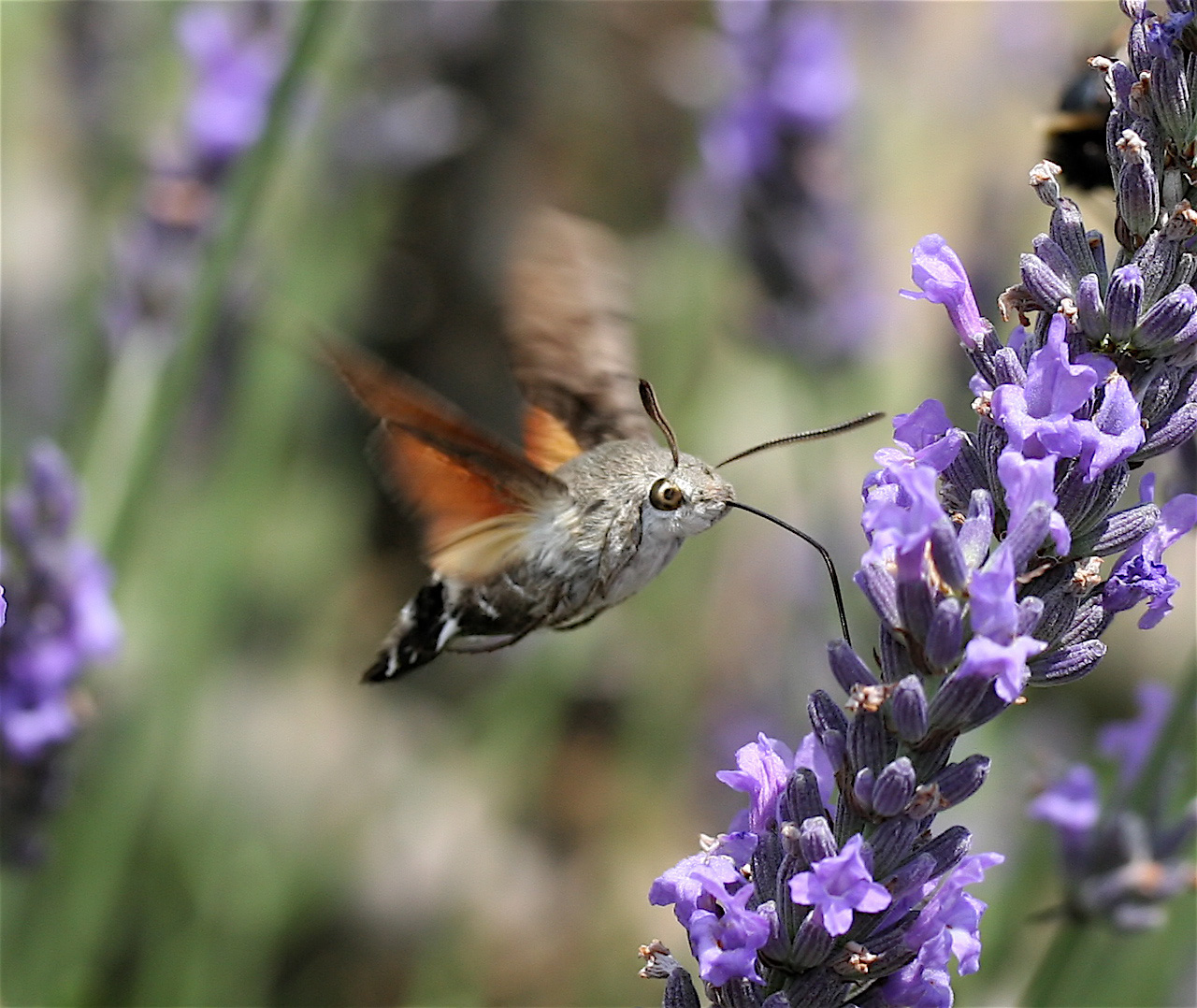- Macroglossum stellatarum
Taxobox
name = Hummingbird Hawk-moth

image_width = 250px
regnum =Animal ia
phylum =Arthropod a
classis =Insect a
ordo =Lepidoptera
familia =Sphingidae
genus = "Macroglossum "
species = "M. stellatarum"
binomial = "Macroglossum stellatarum"
binomial_authority = Linnaeus, 1758The Hummingbird Hawk-moth ("Macroglossum stellatarum") is a species of hawk moth with a longproboscis , and regularly hovers, making an audible humming noise. These two features make it look remarkably like ahummingbird when it feeds on flowers, a result ofconvergent evolution . It flies during the day, especially in bright sunshine, but also at dusk cite journal
last = Herrera
title = Activity pattern and thermal biology of a day-flying hawkmoth ("Macroglossum stellatarum") under Mediterranean summer conditions
journal = Ecological Entomology
volume = 17
pages = 52–56
date = 1992
doi = 10.1111/j.1365-2311.1992.tb01038.x] , dawn, and even in the rain, which is unusual for even diurnal hawkmoths cite book
last = Pittaway
first = AR.
title = The Hawkmoths of the Western Palaearctic
publisher = Harley Books, London
date = 1993] . Its visual abilities have been much studied, and it has been shown to have a relatively good ability to learn colours cite journal
last = Kelber
first = Almut
title = Colour learning in the hawkmoth "Macroglossum stellatarum"
journal = J. Exp. Biol.
volume = 1119(5)
pages = 1127–1131
date = 1996] .Distribution
The Hummingbird Hawk-moth is distributed throughout the northern
Old World from Portugal to Japan, but is resident only in warmer climates (Portugal, Spain, Germany, Italy, Greece, Turkey, North Africa, and points east). It is strongly migratory and can be found virtually anywhere in the hemisphere in the summer. However it rarely survives the winter in northern latitudes (e.g. north of theAlps inEurope , north of theCaucasus in Russia, etc.).Moths in the "
Hemaris " genus of the familySphingidae are known as "hummingbird moths" in the US, and "bee moths" in Europe, which sometimes causes confusion between this species and the North American genus.Life cycle
Two or more broods are produced each year. The adult may be encountered at any time of the year, especially in the south of the range, where there may be three or four broods. It overwinters as an adult in a crevice among rocks, trees, and buildings . On very warm days it may emerge to feed in mid-winter.
Eggs
The glossy pale green eggs are spherical with a 1 mm diameter. They are said to look like the flower buds of the host plant "
Galium ", and that is where the female lays them. They hatch 6 to 8 days after laying . Up to 200 eggs may be laid by one female, each on a separate plant.Larvae
Newly hatched
larva e are clear yellow, and in the second instar assume their green colouration.The larva is green with two grey stripes bordered in cream along the sides and the horn at the rear end typical of sphingids. The horn is purplish red, changing to blue with an orange tip in the last instar . They feed fully exposed on the top of the host plant and rest in among a tangle of stems. Although dependent on warmth and sun, the larval stage can be as rapid as 20 days.
Pupae
The
pupa e are pale brownish with a prominent, keeled proboscis, and two sharp spines at the end of thecremaster . They are enclosed in loose silken cocoons among the host plant debris or on the ground among leaf litter .Adults
The forewings are brown, with black wavy lines across them, and the hindwings are orange with a black edge. The abdomen is quite broad, with a fan-tail of setae at the end. The wingspan is 40-45 mm.
In the southern parts of its range, the Hummingbird Hawk-moth is highly active even when temperatures are high, and thoracic temperatures above 45 °C have been measured . This is among the highest recorded for hawkmoths, and near the limit for insect muscle activity
Host plants
Larvae usually feed on bedstraws or
madder s ("Rubia") but has been recorded on otherRubiaceae and "Centranthus", "Stellaria" and "Epilobium" .Adults are particularly fond of flowers with lots of nectar (e.g. "Jasminum", "Buddleia", "Nicotiana", "Primula", "Viola", "Syringa", "Verbena", "Echium", "Phlox" and "Stachys" ). They are reported to trap-line, i.e. return to the same flower beds at about the same time each day.
Gallery
In Popular Culture
Rock band
They Might Be Giants devoted a song to the Hummingbird Hawk Moth on their 2007 album "The Else ".References
Links
* [http://www.leps.it/indexjs.htm?SpeciesPages/MacroStellat.htm All life stages pictured]
* [http://tpittaway.tripod.com/sphinx/m_ste.htm More photos, and Pittaway's description]
Wikimedia Foundation. 2010.
